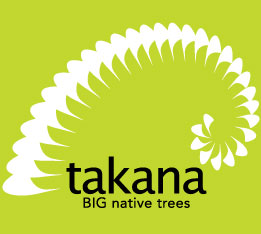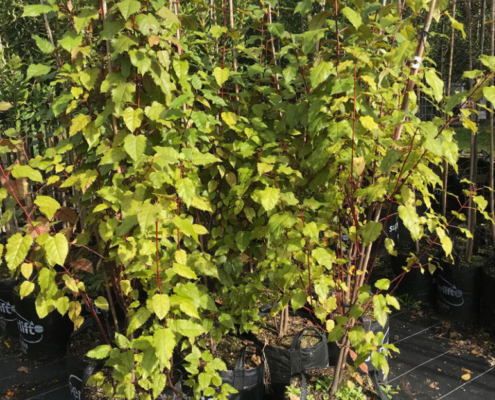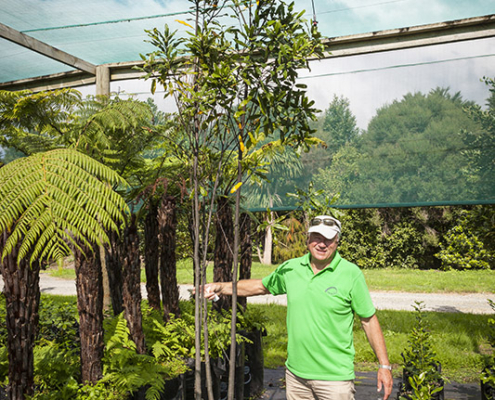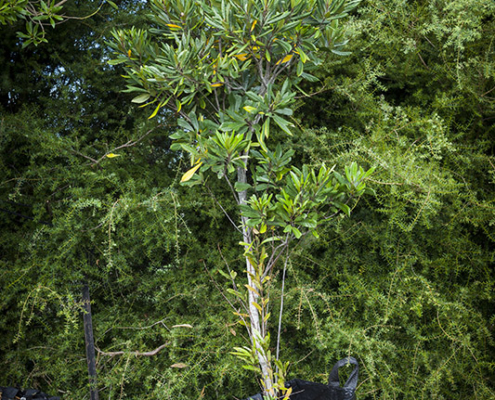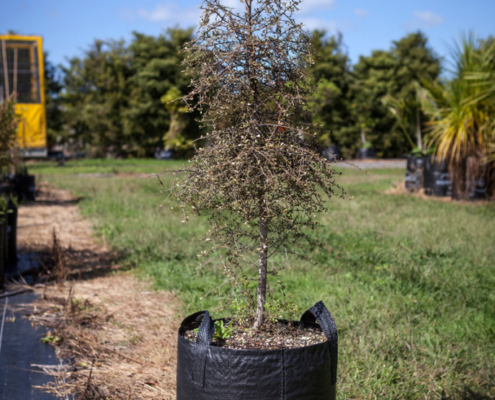Drag your eye from the daily drill, and set it upon the hearty light of a family of New Zealand’s endemic tree species, Elaeocarpaceae. This is a family of mostly tropical trees and shrubs.
The genus Elaeocarpus is constituted of approximately 350 mainly tropical tree species found throughout Australia, Indonesia, East Asia, Malaysia, the Pacific Islands, and New Zealand.
In the botanical world, plants are scientifically ranked according to their biological classifications, thus the overall ranking is ‘Family,’ and includes the entire group of related plants. Below the Family, we see a Genus classification which refers to a type of plant within the Family. Below Genus (plural genera), further botanical differentiation is offered by the term, Species, which refers to plant types within a genus that exhibit particular characteristics. A Family may contain many genera, and a Genus may contain many Species, some of which might bear no resemblance to others in their genus.
So, in New Zealand we have representatives of just two of twelve Elaeocarpus genera, the whole of which include 600 species. Both New Zealand genera are endemic. Elaeocarpus and Aristotelia represent just four native species, Hinau (E.dentatus), Pokaka (E.hookerianus), and Makomako (A. serrata), and Mountain Wineberry (A. fruticosa). The E and A ahead of these latin handles refer to the Genus to which these plants belong, and the names that follow, to the Species, but they are all Elaeocarps.
Aristotelia draws its name from Aristotle, the pre-christian era Greek philosopher. The Aristotelia genus is confined to the southern hemisphere and contains 24 species of shrubs and small trees found in Australasia, Vanuatu and South America.
Makomako (Aristotelia serrata) is a hardy spreading tree which grows from 6m-10m. Its’ soft leaves are apple-green with markedly serrated edges. From September to December inflorescences laden with fragrant delicate drop-like flowers ranging from white through pink, to wine-coloured, appear in profusion and dress the tree extraordinarily attractively. From November to January the red currant-like fruit matures to black, providing a welcome bounty for tui, kereru, bellbirds, silver eyes, kakariki and other birds. Relatively common, Makomako is dioecious and grows freely in forests from one end of the country to the other and is often found on forest edges. Of a lesser life-span, Aristotelia serrata is nevertheless an excellent nurse crop and delivers a fast lightweight canopy. It grows robustly on most soil types although it prefers moist soil.
Aristotelia fruticosa is a small-leafed gangly shrub which grows to about 2m height.
Hinau (Elaeocarpus dentatus) is an evergreen low country species growing as far south as Christchurch. It’s widely, though sparsely spread in the North Island up to 1000m. Hinau grows 15-20m in height with the trunk stopping at around 7m. The top billows up into an expansive round crown supported by many branches with dark green vaguely serrated coriaceous leaves are at their tips. Elaeocarpus dentatus flowers are drop-like cream-coloured blooms which, in a robust season cover the entire tree in a show-stopping display. The fruit matures from April through June into deep purple 2cm long fruit with a fleshy outer layer around a central nut. Kereru love them and are a primary disperser of the seed through their droppings.
Pokaka (Elaeocarpus hookerianus) is similar, though smaller than Hinau, growing to a maximum of 15m. It divaricates as a juvenile with a messy tangle of branches until it matures into a tree form with larger leaves and a narrow compact crown carried by sturdy upright branches. Initially a slow grower, Pokaka doesn’t bloom until it has grown out of the juvenile form. Once adult, small green-white flowers open between November and January and are similar to Hinau, but good flowering years in some areas can be sporadic. The 1cm plum-like fruit ripens to dark purple from April to June. E.hookerianus is found over most of the country, but is sparsely distributed, even rare, throughout the North Island. It withstands high wind, even in insubstantial soils, and grows well on most soils, including poorly drained sites. Pokaka adapts well to full sun or partial shade.
More, more, more on the Elaeocarpacaea Family’s native New Zealand citizens
- Makomako (A.serrata) berries were eaten by Maori children, and early Europeans made jelly from the fruit.
- Early Europeans also used the berries to make what was a deemed a first rate wine, which led to it being called, Wineberry.
- The bark contains beta-sitosterol, a chemical used to lower blood cholesterol levels, and dicoumarin ellagic acid.
- Maori used the leaves as a poultice to treat burns, and an extract from the leaves boiled in water was used to treat burns, rheumatism, boils, and sore eyes.
- Propagation is from fresh seed collected from January to March
- Stratify seed for 3-4 weeks – should germinate within 4 weeks of sowing.
- Semi-hardwood cuttings taken during spring or summer can also be successfully propagated.
- Wood is white, straight-grained and low density
- Hinau ( dentatus) – Maori collected piles of the fruit and soaked them for a long time in water. With further processing, the flesh was baked into loaves in times of food shortage.
- The bark was occasionally used to create vessels for fluids, and it was widely used for dyeing.
- A decoction from the bark was used to salve the most severe of skin diseases.
- Bark has a high tannin component (20%) and contains beta-sitosterol
- The gum was used as a tattooing pigment, and the wood used for canoe bailers, spears, and splitting wedges.
- The timber is a hardwood which in older trees may have a black heart, much prized by early settlers.
- It has fine even texture, is strong, and resilient, but borer find it more than palatable.
- Aside from the black heart, Elaeocarpus dentatus is not durable
- Pokaka (hookerianus) timber is white, both heart and sapwood. It is not especially durable but once creosoted has been viably used as railway sleepers. It’s a hardy timber of substantial strength, and well-suited to interior uses such as rafters, and beams in house building.
- Neither Hinau or Pokaka burn well, even when dry.
- Pokaka seed can be collected from June for propagation.
